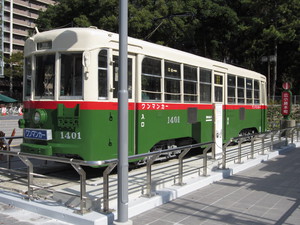Nagoya City Science Museum
TOP > Exhibition Guide > Keyword Search > Starting with "B" > bogie > 1400 Nagoya City Streetcar
1400 Nagoya City Streetcar



Purpose of Exhibition
A streetcar, which is deeply connected with Nagoya city, is displayed in the yard outside this museum as well. We would like you to deepen your understanding of transportation, train, and electricity.
Additional Knowledge
<What is the 1400-type car?>The streetcar made its debut in Nagoya city in May 1898 (the 31st year of the Meiji era) and started service between Sasashima-cho and the Prefectural government office (near the present Nakamura ward office). This project promoted by the Nagoya Electric Railway was an epoch-making one in Japan, only next to Kyoto. In 1922 (the 11th year of the Taisho era), the streetcar system became a municipality-run service and was discontinued entirely in 1974 (the 49th year of the Showa era). This 1400-type car was designed by engineers the Nagoya City Electric Bureau and Nippon Sharyo and was built in 1936. To overcome its predecessor's shortfalls such as heavy weight and large electric consumption, it was built to achieve lightweight construction and streamlined design. Compared to the old one, it made an innovative change. Thus, the 1400-type was representing the streetcar in Japan before the war. Firstly, 20 1400-type streetcars were manufactured between December 1936 and February 1937. They were to transport the audience for The Pan-Pacific Peace Exposition. After that, they were improved five times and 75 streetcars were built in total by April 1942 (the 17th year of the Showa era). Some derivative models were also produced after the war, but most of them were retired earlier, while this 1400-type car survived until its service was discontinued.
<Structure of the Bogie>
Its bogie truck also needs to be included as an important part of the 1400-type. A Bogie truck is an inclusive term of trucks with a devise revolving parallel to the car body. Trolleys with a bogie are called bogie as well.
In a trolley with a short body, the two axles and body were connected directly with the suspensions. As the body gradually became bigger and longer due to an increase of the transportation capacity, it was getting difficult for the fixed axles to run on curved surfaces. In this sense, a truck equipped with a structure revolving to some extent apart from the trolley body was invented. This is the bogie.
<Development and Streetcar of Nagoya>
It was 1937 (the 12th year of the Showa era) which was the year of a great development of Nagoya city. On February 1st, Nagoya Station was transferred to the present site from Sasashima-cho, and it was dubbed as the number one railway station in the East at that time. Subsequently, Higashiyama Zoo and Botanic Garden opened on March 3rd, and 24th respectively and a large number of tourists visited from neighboring areas. Moreover, The Nagoya Pan-Pacific Peace Exposition was held at Atsuta-mae-shinden (near the present Komei-cho Minato ward) from March 15th to May 31st. On the sidelines of these, the streetcar system expanded into the west, east, and the south of Nagoya and the -1400type was constructed with the slogans of "The world number one streetcar supplying the expo", and "The standard model of Nagoya's streetcar for the future".
Cooperation: Nagoya City Transportation BureauArticle by Koichi Mabuchi, curator
